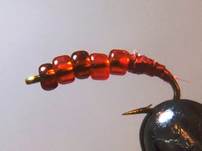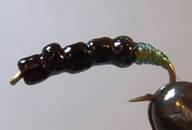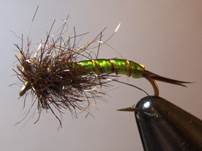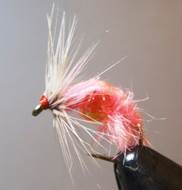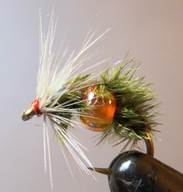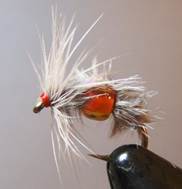LATE & EARLY SEASON FISHING AT DEPUY'S SPRING CREEK (part 10)
| Sysadmin Note |
|---|
| Part 9 can be found here |
Shotgun Nymphing - Understand the Riffle
Riffles in spring creeks are "food conveyors" for trout. Shallow structures let sunlight penetrate water column and cause photosynthesis with aquatic weed-beds. Tumbling water is oxygenated and typically cooler than calm/flat spots. Combining these two facts, riffles produce and host miscellaneous mayfly nymphs, larvae (midge, caddis, and crane fly), and aquatic foods (scuds, sowbugs, snails, and so forth). When stepping into choppy and tumbling surfaces of riffles, every angler must understand that the water column is not moving as fast or strong as the surface. Trout know all of these facts as they have been thriving and evolved in this environment. All they have to do is hold with ease in the water column and wait for foods drifting toward their mouths. They can break and feed on the surface when something curious is floating (such as terrestrials). Also choppy surfaces serve as protective covers from predators on the bank (human, bear, coyote, etc.) or in the air (heron, eagle, etc.). On the contrary, for anglers riffles don't look attractive. First, the choppy surfaces don't attract anglers who expect to fish flat water of spring creeks. One can have good dry-fly fishing at riffles too!! Second, even when attempting with nymphs and streamers, most of anglers face confusion and can't find correct methods. Third, they don't realize that choppy surfaces and gurgling sounds serve as camouflages for anglers (as well as a protective barrier for trout) hence they can get closer to trout. Consequently, the Middle Section of DePuy's is left untouched. Most anglers (with or without guides) tend to congregate on the Upper or Lower Sections.
Blast Your Shotgun:
One shotgun shell contains multiple pellets. Just with one trigger, it attacks a "sphere" at once rather than a single "spot". We fly-anglers are not equipped with multi-rods or -flies (dozen? or 30 of them), so what we do is we cut the river/creek into pieces = grids = and make relatively short distance castings repetitively in one grid. Although the shotgun method (or shot gunning) can be used for dry-fly fishing, here I focus on nymphing at riffles. Then again, I use Middle Section of DePuy's as a case study in the "classroom of fly-fishing". Accompanied drawing and pictures will give you virtual tour and images. Step into the creek 15 to 20 feet down-stream from the riffle you intend to fish and face up-stream.
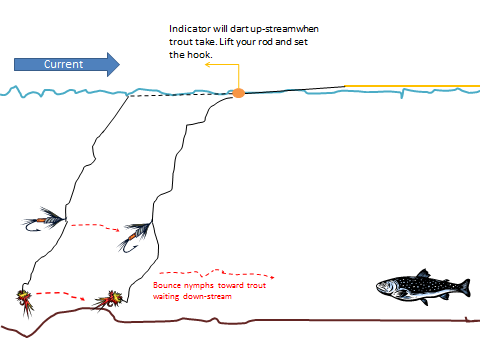 What's going on under water? |
Grids & Casting:
With the size of DePuy's, I assign my grids from 5' x 5' to 7' x 7'. Casting is nothing but a simple over-head cast aiming up-stream. Distance is 12 to 20 feet. I don't really retrieve my fly-line when my indicator (flies) is floating down-stream toward me. Instead I gently lift my rod-tip in order to keep some tension on my fly-line. When trout take, the indicator will dart up-stream. Then I set the hook by lifting my rod-tip and giving extra tension on my fly-line with my line-hand. If there is no bite, I let my rig float perpendicular to me and down-stream from me (oftentimes, I experience strikes even around there!). I don't make a typical back-cast and I don't suggest others do so. Instead I let currents take my leader down-stream from me and I simply flip my leader up-stream (Water Haul). Or I use a simple Roll Cast. These two methods will prevent from tangling the nymph set-ups. Repeat this procedure 20 to 30 times at one grid. Then move on to next grid and so forth. It's a totally different nymphing from just waiting for a bobber to sink. Often, I am totally into it and lose the sense of time until dusk. Indeed Shotgun Nymphing is a very aggressive, efficient, and deliberate way to aim and search trout at the same time.
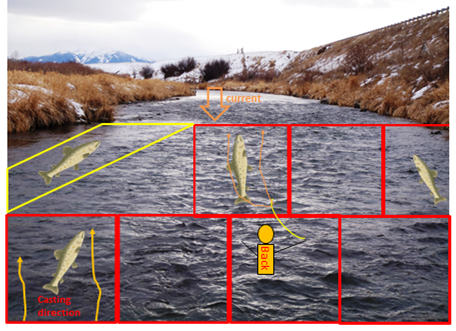 Example of grid. Square grids (red) and also Yellow grid covers a slow spot between the bank and edge of riffle. Cast repetitively in one grid and move to next! |
Tight Along the Bank:
If riffles were the only concern, that would be the end of story. However, there's more to do with Shotgun Nymphing in the Middle Section. First with this method, one can target trout that are holding tight and close along cutbanks with over-hanging grass. As I explained in the last chapter, this structure is tempting to fish with streamers. However just walking over the banks (before wading into the creek), oftentimes some big trout would get spooked and swim away from the cut banks. By approaching cutbanks from down-stream, one can be stealthy from trout and sounds and movements of riffles camouflage our presence and movements. When I try to cover tight along cutbanks, my grid will be such as 2' x 5' or 1' x 6' and so forth. Cast a few to several feet up-stream of targets and let nymphs drift down-stream.
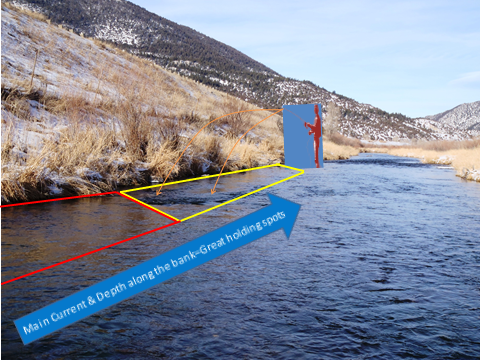 Grids along the cutbanks with over-hanging grass. |
Shoot the "Chute":
The Middle Section has one more structure to consider = under water weed-beds. Remember, again in last chapter, that I was spooking more trout that were resting/hiding among weed-beds? It was very frustrating and seemingly impossible to target those trout at that time. By employing Shotgun Nymphing from down-stream of those weed-beds, I can fish "chutes" between or among weed-beds without snagging weeds. This was a revelation, and I started to take trout so consistently from where it was impossible and where others told me "unproductive"!! Then I realized why regular nymphing would not work well at the Middle Section. It's simply hard to target and search between weed-beds by casting cross-current and mending line up-stream. Consequently, decent drifts are hard to be achieved. To sum up, I target the same trout at the same holding spots but I adjust and change "angles of presentation". That makes the big difference. Then, why are trout among weed-beds? They are hiding from threats and waiting for foods (nymphs, larvae, scuds, snails, etc.) washed away toward their mouths. Only once in a while, I locate trout over weed-beds for whatever reason is. But considering the depths of DePuy's, trout know where to hide and rest without being seen by predators. All of these explain why the Middle Section can be deceptive and is often referred as "unproductive". Well, not for me anymore.
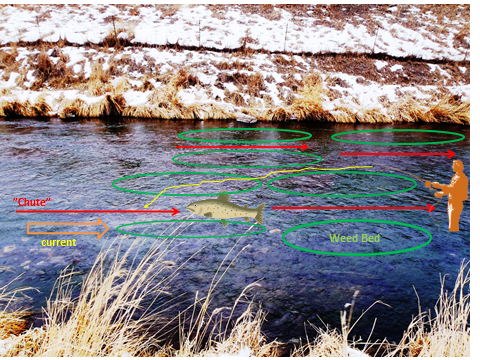 Target "chutes" between weed-beds by Shotgun Nymphing. |
Rigging:
I'm comfortable with my 6weight, 9-foot rod for nymphing. I always fish with (or experiment with) two nymph patterns. My leader-tippet is 9 to 10 feet to the first fly and dropper tippet is 16 to 20 inches. When huge spawning trout are expected, I use 2X for the first fly and dropper tippet would also be 2X or 3X. With this set-up, it's easy and quick to haul in huge trout without breaking, even when they happen to be foul-hooked. When the water level is apparently low (after weed-beds die down in early December) under bright sunny winter days, I switch into 3X and 4X for the first and second fly respectively. Most of nymph patterns I use are size 12 to 22 (with some exceptions of large ones) so I apply my dropper-tippet with the "eye-to-eye connections" between two nymphs. I apply one BB size non-lead split shot at a tippet connecting knot above the first fly. The indicator should always be measured from the first (top) fly. I usually set up my indicator 4 feet above the first fly for the Middle Section. Indicators used for this rigging and fishing method are not necessarily afloat all the time or meant for suspending nymphs in certain depths. I don't recommend balloon types for Shotgun Nymphing. Though it floats well and is very visible, it pops too much every time it's picked up from water for next casts. My favorite indicators = sensitive, visible even under water, and aero-dynamic = are Fish-Pimp and Pinch-On in assorted colors.
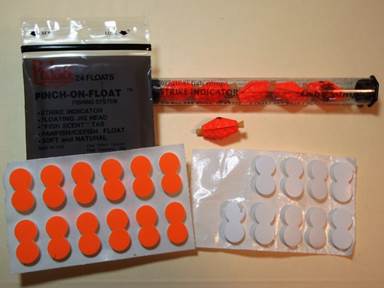 Pinch-On and Fish-Pimp in assorted colors. |
Favorite Nymph Patterns:
I omit the "Otter's Egg" as I already introduced it in the early chapter. All of these are based on insect samples of my kick-seining or stomach-pumping. I tested many a time and these have been proven to catch trout consistently. I'd like to give some spotlights on aquatic food sources that are often underestimated too.
|
|
|
Yamamoto's L.L. Beads – Red |
Yamamoto's L.L. Beads – Black |
Yamamoto's Chewy Green Caddis Larva |
This simple & easy tie represents all sizes of aquatic worms and midge larvae. You have to find extra small beads for hooks #20 and smaller. |
One size represents tiny leeches and cased caddis larva. Flash butt-end looks exactly like a peeking larva! |
While L.L. Beads – Black represents cased ones, this represents free-living cousins. I can't emphasize how many of these are swimming in the creek. They are often underestimated due to popularity of mayfly nymphs by anglers. But trout love them! |
|
|
|
Yamamoto's SCEGG – Pink |
– Olive |
– Gray |
Hook: Scud hook size 10 and 12 |
This is the ultimate combination of egg plus scud (hence the name). I designed this with durability in mind. Hot orange bead imitates both trout eggs and pregnant scud. Pink is definitely an effective during spawning periods. Olive and gray imitate scud and sowbug respectively. These work even before and after spawning periods. |
|
Shotgun Nymphing is the way to go. I felt the formerly impossible places to fish were suddenly opened up for me. Even during my learning phase, I could tell I was growing into a better angler and developing new views and skills. I have enjoyed total solitude and I have caught lots of trout, including some really big ones. I have located and observed spawning redds here and there at some selected locations of the Middle Section, which not all anglers (even Pass holders) are aware of. No wonder there are so many big trout! Nowadays, I never fear the Middle Section any more. Instead it became one of my favorite sections (well, I like to fish the entire creek anyway…..)!! I can take trout consistently and guide my clients with confidence. And indeed Shotgun Nymphing can be applied every riffle in DePuy's and any other spring creeks. But Mother Nature = in Livingston's case, infamous winds = always gives us challenges and makes it necessary for us to modify/adjust things………
Satoshi Yamamoto, http://leftyangler.blogspot.com, brought his passion for fly-fishing & fly-tying from Japan to Montana and became the first ever Japanese guide in Livingston, MT. He guides and fishes big rivers like Madison & Yellowstone, spring creeks in Paradise Valley, and various waters in Yellowstone Park. Hence, with his Regal Vise at the bench, his fly tying interests vary from tiny midges to 5-inch streamers and anything in between. Once his ideas are combined he goes out for experiments at those near-by waters. Satoshi submits his innovative patterns to Montana Fly Company (www.montanafly.com).
His own innovative original patterns can be purchased from his fly-shop, http://leftytyer.blogspot.com.
| Sysadmin Note |
|---|
| Part 11 can be found here |

